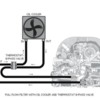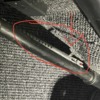I have an umbrella e-brake. Mine is an original 356 arrangement inside the cabin, adapted to the car from there. This is a horribly expensive way to go about doing it, because there are only so many old 356 e-brake handles not attached to a 356 still in circulation. I'd suspect yours is a generic version of the pull handle.
If I understand what's going on, it looks like the inner shaft (which the handle pulls) popped out of the "barrel" (the fixed portion of the program) which is probably just a rolled piece of sheetmetal, not welded along the seam. At the end of the inner shaft there is likely a cable that goes down to a bell-crank (probably mounted to your beam), which in turn pulls the e-brake cables.
There's not an infinite amount of real estate under your dash or on your beam, which is probably why you are noticing the alignment issue. I'd suspect that if the pieces were in alignment, the relationship of the handle to the steering column would not be right. Regardless, this is why there's a cable - to make up for any misalignment.
As frustrating as it's been for you, it looks like a very easy fix, at least if the pictures are showing me what I think they're showing me.
If the problem is that the inner shaft keeps popping out of the seam of the barrel, you just need to keep it in there, and everything will work. I'd try a couple of worm-gear hose clamps around the outer barrel - one high and one low - to keep things where they need to be.
It'd cost $3, and would save you a lot in increased BP.
Welcome to the Madness.
























